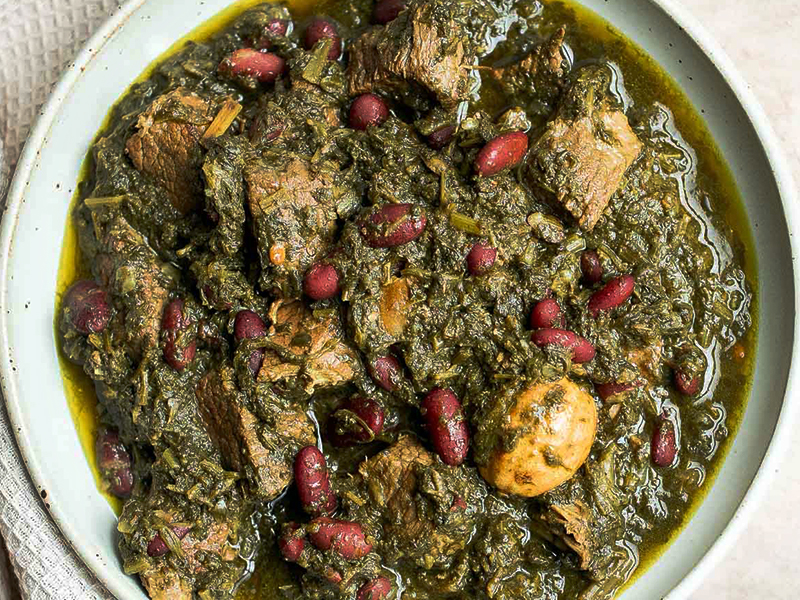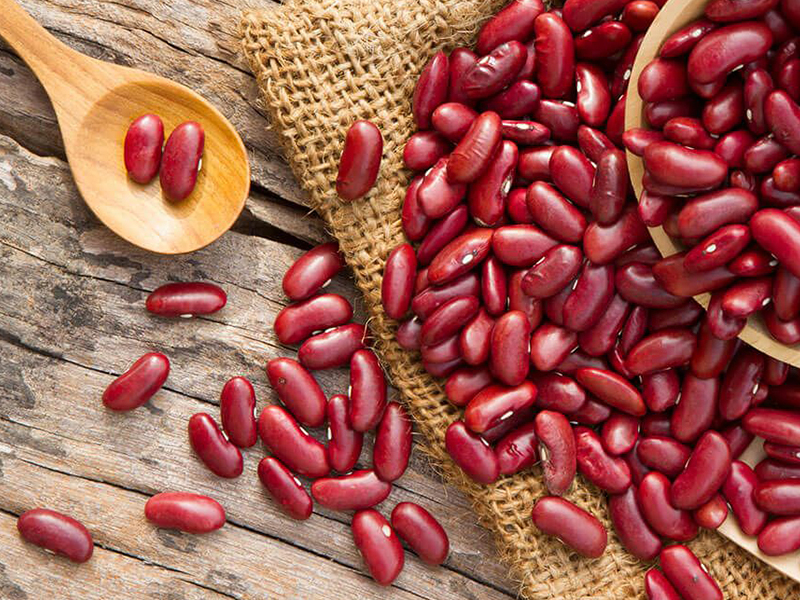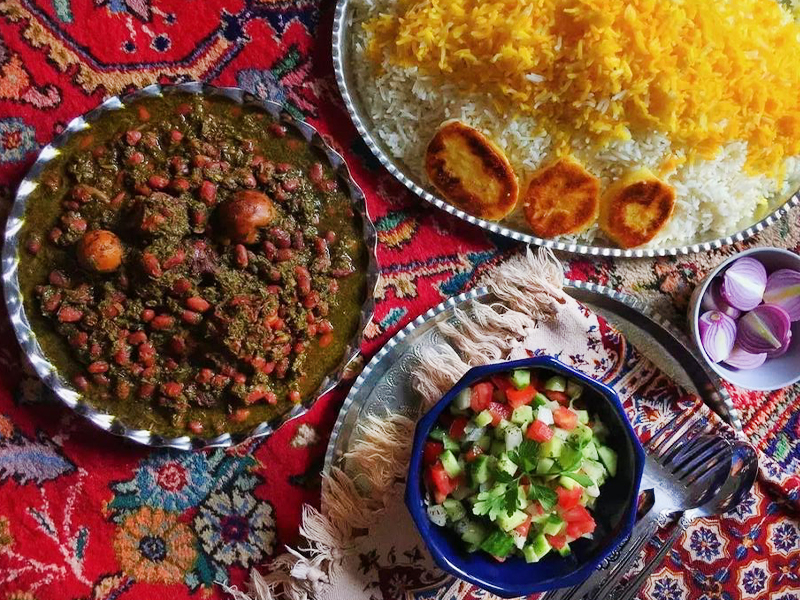Ghormeh Sabzi: Persian Herb Stew, Recipe, Ingredients
Iran has a rich culinary collection of foods and dishes that cater to any taste; many of these dishes are now famous worldwide. Iranians have a strong affinity for food, which is firmly ingrained in their culture and traditions. Food is important in Iranian culture, and meals are considered a time for gathering, celebration, and bonding. Iranians are recognized for their hospitality and generosity when it comes to sharing meals, and they take great pride in their culinary heritage. In this article, we will introduce Persian Herb Stew, also known as Ghormeh Sabzi, one of the famous Persian dishes that you should try.
Ghormeh Sabzi (Persian Herb Stew)
Ghormeh Sabzi is a beloved and iconic Persian herb stew that holds a special place in Iranian cuisine. It is considered one of the national dishes of Iran and is cherished for its rich flavors and aromatic herbs. Qormeh Sabzi has a long history that dates back centuries in Iran. The dish’s roots can be traced to ancient Persia, where it was originally prepared as a way to preserve and enjoy the flavors of fresh herbs during the cold winter months. The use of herbs, such as parsley, cilantro, and fenugreek, reflects the ancient Persian tradition of utilizing local ingredients and culinary practices.
Ghorme Sabzi, Symbol of Iranian Foods
Qormeh Sabzi is a sign of Iranian identity and cultural history, as well as a culinary delight. Iranians have a strong emotional attachment to this meal, which symbolizes their appreciation for the rich flavors, bright smells, and traditional cooking methods that characterize Iranian cuisine. Qormeh Sabzi is frequently connected with family reunions, special occasions, and joyous festivities, where it serves as the meal’s focus, bringing people together and cultivating a sense of shared culture and heritage.
What Is Ghormeh Sabzi Made of?
Ghormeh Sabzi is a traditional Persian herb stew cooked with finely chopped fresh herbs sautéed in oil, such as parsley, cilantro, and fenugreek leaves. Cubed lamb or beef, boiled red kidney beans, and tart-dried Persian limes are mixed into the sauce. Turmeric, salt, pepper, and sometimes ground cinnamon are used as seasonings.
Slow cooking in water or broth allows the flavors to mingle and the meat to tenderize. Ghormeh Sabzi is a culinary and cultural icon of Iran. It is adored for its complex flavors and smells, as well as the communal experience it promotes. This traditional meal, served with steaming basmati rice, reflects culinary pride and is relished on special occasions, bringing people together in celebration of their ancestry.
Ghormeh Sabzi Recipe
There is nothing more flavorful and fragrant than Ghormeh Sabzi, a Persian herb stew whose flavor and scent go beyond your senses. If you want to make this Persian Herb Stew and need Ghormeh Sabzi, you should follow the mentioned steps. Firstly, brown cubed lamb or beef in oil or ghee then set it aside. In the same pot, sauté finely chopped parsley, cilantro, fenugreek leaves (optional), and green onions until fragrant.
Return the meat to the pan and season with turmeric, salt, and pepper before covering with water or beef broth. Simmer for 2-3 hours or until the meat is soft. Simmer for 30 minutes after adding pierced dried Persian limes and cooked red kidney beans. Season to taste and serve over heated basmati rice. Ground cinnamon and sautéed onions are optional additions.
Ghormeh Sabzi is a popular Persian dish representing culinary pride and cultural identity. The rich scent, mixed with aromatic herbs and zesty limes, will designate an amazing and comfortable experience. With family and friends, enjoy this traditional Iranian stew.
Ghormeh Sabzi Vegetarian
For those who are on a plant-based diet or vegetarians, Ghormeh Sabzi includes another version that there isn’t any meat involved in its preparation. Vegetarian Ghormeh Sabzi is a plant-based adaptation of the traditional Persian herb stew. It substitutes protein-rich alternatives such as beans or tofu for meat. Fresh herbs like parsley, cilantro, fenugreek, and green onions continue to be the main ingredients, offering bright flavors.
The herbs are sautéed before being combined with the chosen protein source, spices, dried Persian limes, and a simmering liquid. The stew is slow-cooked to allow the flavors to develop. Vegetarian Ghormeh Sabzi provides a nutritious and fulfilling alternative for people on a meatless diet while retaining the essence of the original dish.
Ghormeh Sabzi Main ingredients
Fresh herbs like parsley, cilantro, fenugreek leaves, and sometimes scallions or leeks are the major components of Ghormeh Sabzi. The stew, which is traditionally made with cubed lamb or beef, can also be made with vegetarian options such as kidney beans or tofu. Persian limes, dried, add an intense flavor. Red kidney beans, spices including turmeric, salt, and pepper, and cooking oil for sautéing are also Persian Herb Stew included.
The cooking liquid is either water or broth. When these ingredients are combined and slowly cooked, they form the rich and aromatic Persian Herb Stew. It is usually served with steamed rice to round out the meal and complete the taste of the dish.
Why Is Persian Herb Stew Popular?
Persian Herb Stew or Ghormeh Sabzi is beyond being a typically popular Iranian dish, especially in Iranian communities all around the world. It is a symbol. Qormeh Sabzi is extremely important to Iranians for a variety of reasons.
First and foremost, it is a source of culinary pride, embodying the essence of Iranian cuisine through the use of fresh herbs, slow-cooking techniques, and harmonizing flavors. Furthermore, Qormeh Sabzi is closely entwined with Iranian cultural identity, being passed down through generations and connecting people to their ancestors.
The peculiar flavors and fragrances of the dish, which are produced from sautéed herbs, delicate meat, and tangy dried Persian limes, trigger nostalgia and comfort, reminding Iranians of home and their culinary traditions.
Lastly, Qormeh Sabzi functions as a social bonding stimulus and is frequently consumed in communal occasions in which family and friends gather around a Sofreh (tablecloth). Sharing a Qormeh Sabzi as a meal grows social relationships, fosters togetherness, and emphasizes the importance of family and community in Iranian culture. Here’s a bonus: Ghormeh Sabzi tastes heavenly with Shirazi Salad.
Ghormeh Sabzi Calories
The caloric content of ghormeh sabzi can vary depending on the ingredients and preparation method used. However, according to estimates, a typical serving (approximately 1 cup) of ghormeh sabzi contains around 250-300 calories.
Here are some additional calorie estimates for different variations of ghormeh sabzi:
With beef: 350-400 calories per cup
With lamb: 300-350 calories per cup
Vegetarian: 200-250 calories per cup
With kidney beans: 280-320 calories per cup
Homemade Ghormeh Sabzi, the Best Version
Making this stew at home offers several advantages. It allows you to create an authentic representation of this iconic Persian dish, ensuring the use of traditional ingredients and techniques. Homemade Ghormeh Sabzi also allows customization, meaning that you can try the different variations based on your preference.
Using fresh, high-quality ingredients is another benefit when you make the Ghormeh Sabzi at home. Overall, homemade Ghormeh Sabzi is the best version of Persian Herb Stew that you can try. Also, we should mention that if you want to try Ghormeh Sabzi inside or outside of Iran, check out the Best Persian Restaurants nearby to get the best result of your culinary journey.
Final Words
The love of food in Iran is a reflection of the country’s rich cultural heritage and the passion Iranians have for their culinary traditions. It is a way for them to express their creativity, share their culture, and create meaningful connections with others. The appreciation for food is deeply ingrained in Iranian society, making it an integral part of their daily lives and celebrations. Ghormeh Sabzi, or Persian Herb Stew, is a great culinary option that will bring joy to any taste. Make sure to try the Ghormeh Sabzi Recipe at home with your family.
Are you planning to travel to Iran? Check out our Iran tours and Iran food tour.









Leave a Reply
Want to join the discussion?Feel free to contribute!